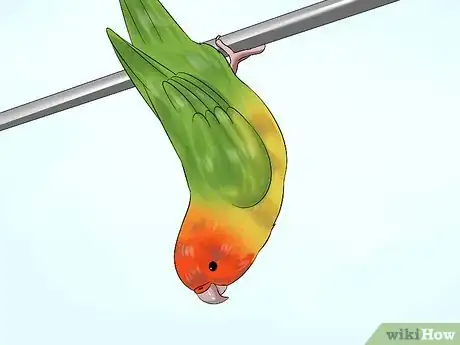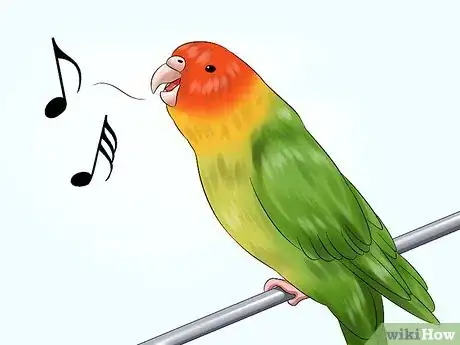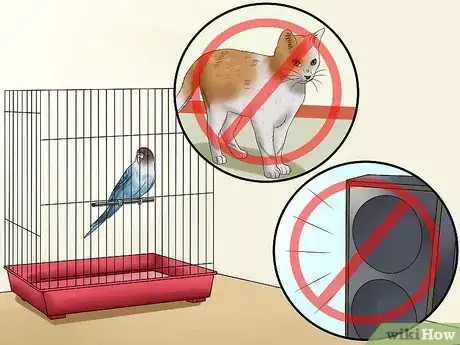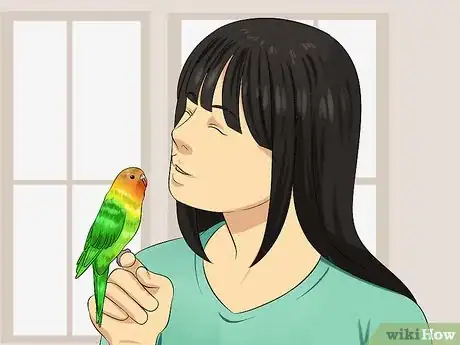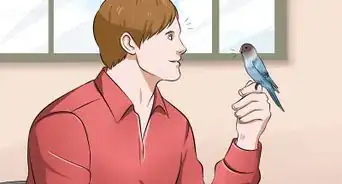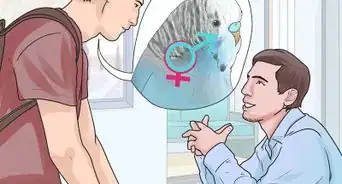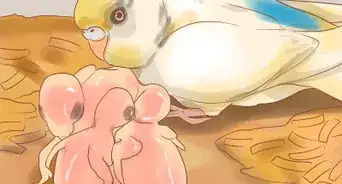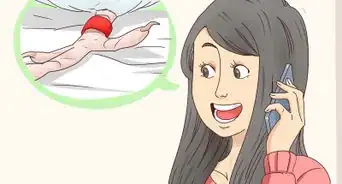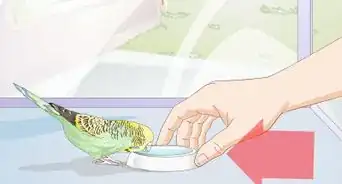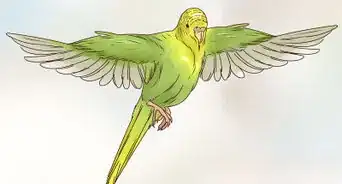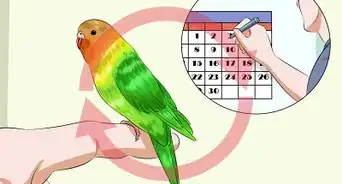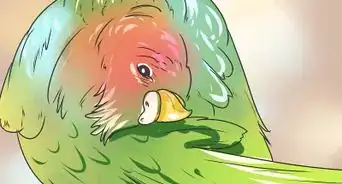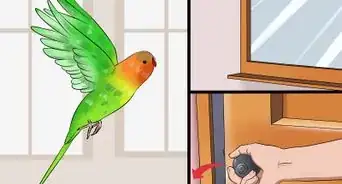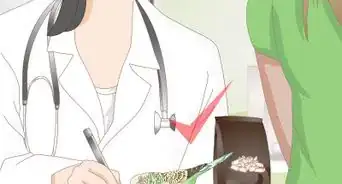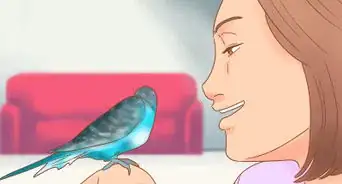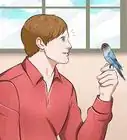This article was co-authored by Pippa Elliott, MRCVS. Dr. Elliott, BVMS, MRCVS is a veterinarian with over 30 years of experience in veterinary surgery and companion animal practice. She graduated from the University of Glasgow in 1987 with a degree in veterinary medicine and surgery. She has worked at the same animal clinic in her hometown for over 20 years.
wikiHow marks an article as reader-approved once it receives enough positive feedback. This article received 25 testimonials and 91% of readers who voted found it helpful, earning it our reader-approved status.
This article has been viewed 485,681 times.
A pet budgie (or parakeet) is a wonderful companion for any bird lover. They are clever, amusing, and relatively easy to train and take care of.[1] Many parakeets are naturally fearful of humans, but with time and training this fear can be overcome, and your parakeet can come to see you as a source of love and affection.[2]
Steps
Observing Body Language to Tell Whether Your Parakeet Likes You
-
1Notice whether your bird cuddles with you. Cuddling is a clear indicator that your parakeet likes you and wants to bond with you. If your bird gently nuzzles against your hand, climbs around on your body, grooms you, and rubs against your neck, you will know that your parakeet likes you and feels safe around you.
-
2Look at your bird's wings. We typically think of a bird's wings as being an instrument of flight, but many birds, including parakeets, use their wings as a sort of body language. If your parakeet is flapping his wings, which may give the appearance of trying to fly in place, it is a good sign of your relationship with your bird. Wing flapping is one way parakeets display happiness around humans.[3]Advertisement
-
3Notice your bird's tail. Just as your parakeet's wings can be an indication of happiness, so too can his tail feathers. When a bird wags its tail (similar to a dog's tail), it usually means that your bird is happy to see you - though it can also indicate that your bird is about to relieve himself. Similarly, flipping the tail up and down is generally considered an indication of happiness, and can be taken as a sign that your bird likes you.[4]
-
4Observe your bird's body posture. The way your parakeet carries himself around you can tell you a lot about how he feels in your presence. Taking his body posture, along with individual pieces of body language like wing and tail fluctuations, can help you get a better picture of your bird's level of comfort around you.[5]
- A bird in a relaxed, non-rigid posture is typically happy and comfortable around his human.[6]
- A bird that "bows" his head - crouching down with his head "pointed" toward his human - is comfortable around that person and may be requesting a head scratching or petting.[7]
- Any kind of rigid body posture, usually accompanied by ruffled feathers and a restless, side-to-side movement, typically indicates discomfort, displeasure, or a lack of trust around a human. If your bird behaves in this manner, it's best to give him space. He either has not yet gotten comfortable around you or does not like something that you are doing. Find out what you are doing wrong and avoid that trigger. [8]
Noticing Movements That Indicate Your Parakeet Likes You
-
1Watch your bird's eyes. While human pupils dilate and constrict in response to light or darkness, a parakeet's pupils can change in size as a physical reaction to the bird's mood and environment. Flashing (the widening of the pupils) and pinning (the narrowing of the pupils) are controlled by the bird, and typically indicate excitement or pleasure, though these behaviors can also be an indication of fear or anxiety.
- If your parakeet's eyes flash and pin when he sees you, it is most likely an indication that he likes you and values your company.
-
2Observe whether your bird hangs upside down. Hanging upside down is a common practice for birds. It is typically done when birds are happy and feel safe, as the position tends to leave the bird vulnerable. If your bird hangs upside down in your presence, it may be a sign that he likes you and trusts you.[9]
-
3Notice your bird's beak and head movements. Parakeets use their beaks for a variety of purposes, from physical tasks to conveying messages. If your bird is performing any of the following activities, it is typically a sign of happiness and comfort around you.
- Grinding the beak, left to right in the same way that people grind their teeth, is a sign of happiness in parakeets.[10]
- Mouthing with the beak, without actually biting, is one way parakeets play with one another. If your bird is gently mouthing you with his beak, without actually trying to bite you, it is probably a sign of affection.[11]
- Regurgitating in front of or "at" a person is a sign of tremendous affection. This is particularly true if your parakeet displays signs of eye pinning and head bobbing immediately before regurgitating.[12]
Listening for Sounds That Indicate Your Parakeet Likes You
-
1Notice any talking, singing, or whistling. These three vocalizations are a common sign that your parakeet is content and happy in your home. If your bird is very vocal, particularly when you walk into the room, it is a good sign that your bird likes you.[13]
-
2Listen for beak chattering or purring. Beak chattering and purring are not always loud; some birds make these sounds softly and silently. No matter how your bird chatters and purrs, it is typically a sign that he is content and wants to interact or play with you.[14]
-
3Pay attention to tongue-clicking. One way parakeets express that they would like to be picked up or petted is by clicking the tongue against the beak. If your parakeet clicks his tongue around you, it is usually a sign that he likes you and wants you to interact with him more.[15]
Encouraging Your Parakeet to Like You
-
1Make sure your bird's physical needs are met. Forgetting to feed or give water to your bird is very dangerous to the bird's health, and could over time reduce your bird's overall happiness and trust in you. Always be sure that your bird has enough clean drinking water, and be sure to feed him an appropriate diet.
-
2Make him feel safe. Your bird views his cage as a home within your home. Making your bird's cage as comfortable as possible will help him feel safer in your home, and may help him feel more caring toward you.
- Be sure your bird's cage is big enough. It should also be kept away from direct sunlight, out of reach from any other pets you may have, and away from loud or frightening sources of noise, such as televisions and radios.
-
3Give your parakeet toys. Parakeets love to play, and providing your bird with fun, challenging toys will make him happy and content.
- Be sure your parakeet has toys that allow him to climb, as well as toys that are colorful and make noise.[18]
- Give your parakeet a swing inside his cage, and make sure he has plenty of perch space inside the cage.[19]
- Get your parakeet toys that are safe to chew on. Look for toys with wooden components, or solid, sturdy beads that can be bitten and chewed.[20]
-
4Encourage your parakeet to trust you. You can do this by showing your bird that you are safe and friendly. Speak to your bird often, and use soothing, calm tones. You should also allow your bird to eat and play outside his cage, and encourage him to interact with you. Over time, your bird will feel safe and comfortable around you, and he will come to show you affection.
Expert Q&A
-
QuestionWhy is my budgie all puffed up?
 Pippa Elliott, MRCVSDr. Elliott, BVMS, MRCVS is a veterinarian with over 30 years of experience in veterinary surgery and companion animal practice. She graduated from the University of Glasgow in 1987 with a degree in veterinary medicine and surgery. She has worked at the same animal clinic in her hometown for over 20 years.
Pippa Elliott, MRCVSDr. Elliott, BVMS, MRCVS is a veterinarian with over 30 years of experience in veterinary surgery and companion animal practice. She graduated from the University of Glasgow in 1987 with a degree in veterinary medicine and surgery. She has worked at the same animal clinic in her hometown for over 20 years.
Veterinarian Fluffing up feathers traps pockets of air and keeps the bird warm. Budgies do this when cold, but it can also be a sign of ill health.
Fluffing up feathers traps pockets of air and keeps the bird warm. Budgies do this when cold, but it can also be a sign of ill health. -
QuestionHow can you tell the gender of a budgie?
 Pippa Elliott, MRCVSDr. Elliott, BVMS, MRCVS is a veterinarian with over 30 years of experience in veterinary surgery and companion animal practice. She graduated from the University of Glasgow in 1987 with a degree in veterinary medicine and surgery. She has worked at the same animal clinic in her hometown for over 20 years.
Pippa Elliott, MRCVSDr. Elliott, BVMS, MRCVS is a veterinarian with over 30 years of experience in veterinary surgery and companion animal practice. She graduated from the University of Glasgow in 1987 with a degree in veterinary medicine and surgery. She has worked at the same animal clinic in her hometown for over 20 years.
Veterinarian The color of the budgie's cere (the 'figure-8' spectacles at the base of the beak) gives a clue to an adult budgie's gender. Males have a blue cere, while females are usually browny-cream.
The color of the budgie's cere (the 'figure-8' spectacles at the base of the beak) gives a clue to an adult budgie's gender. Males have a blue cere, while females are usually browny-cream. -
QuestionWhy is my budgie bobbing its head?
 Pippa Elliott, MRCVSDr. Elliott, BVMS, MRCVS is a veterinarian with over 30 years of experience in veterinary surgery and companion animal practice. She graduated from the University of Glasgow in 1987 with a degree in veterinary medicine and surgery. She has worked at the same animal clinic in her hometown for over 20 years.
Pippa Elliott, MRCVSDr. Elliott, BVMS, MRCVS is a veterinarian with over 30 years of experience in veterinary surgery and companion animal practice. She graduated from the University of Glasgow in 1987 with a degree in veterinary medicine and surgery. She has worked at the same animal clinic in her hometown for over 20 years.
Veterinarian Head bobbing can mean a variety of things. Males head bob as part of a courtship ritual, while young birds may learn to head bob to get food. Some birds head bob as a territorial behavior.
Head bobbing can mean a variety of things. Males head bob as part of a courtship ritual, while young birds may learn to head bob to get food. Some birds head bob as a territorial behavior.
Warnings
- Don't force a bird to do something it does not want to do. Never force your bird to come out of its cage or to be picked up if it does not want these things. Although many birds don't get comfortable around humans the first few days of pickup.⧼thumbs_response⧽
References
- ↑ http://lafeber.com/pet-birds/perks-owning-pet-parakeet/
- ↑ http://vetmed.illinois.edu/pet_column/bird-basics-proper-parakeet-husbandry/
- ↑ http://www.peteducation.com/article.cfm?c=15+1795&aid=3334
- ↑ http://www.peteducation.com/article.cfm?c=15+1795&aid=3334
- ↑ http://www.peteducation.com/article.cfm?c=15+1795&aid=3334
- ↑ http://www.peteducation.com/article.cfm?c=15+1795&aid=3334
- ↑ http://www.peteducation.com/article.cfm?c=15+1795&aid=3334
- ↑ http://www.peteducation.com/article.cfm?c=15+1795&aid=3334
- ↑ http://www.peteducation.com/article.cfm?c=15+1795&aid=3334
- ↑ http://www.peteducation.com/article.cfm?c=15+1795&aid=3334
- ↑ http://www.peteducation.com/article.cfm?c=15+1795&aid=3334
- ↑ http://www.peteducation.com/article.cfm?c=15+1795&aid=3334
- ↑ http://www.peteducation.com/article.cfm?c=15+1795&aid=3334
- ↑ http://www.peteducation.com/article.cfm?c=15+1795&aid=3334
- ↑ http://www.peteducation.com/article.cfm?c=15+1795&aid=3334
- ↑ http://www.nationalbirdday.com/a_happy_bird.php
- ↑ http://www.nationalbirdday.com/a_happy_bird.php
- ↑ http://lafeber.com/pet-birds/top-toys-for-parakeets/
- ↑ http://lafeber.com/pet-birds/top-toys-for-parakeets/
- ↑ http://lafeber.com/pet-birds/top-toys-for-parakeets/
About This Article
To tell if your pet budgie likes you, start by observing its body language and noticing if it’s wagging its tail, flapping its wings in place, or bowing its head, as these are indications that it likes you. If your bird gently mouths you with its beak, it’s likely a sign of affection. Additionally, if your bird hangs upside down in your presence, it means that it’s happy and feels safe around you. Then, listen for the bird to talk, sing, or whistle when you walk into the room, since budgies are vocal around people they like. To learn more from our Veterinary reviewer, like how to get your budgie to like you, read on!





